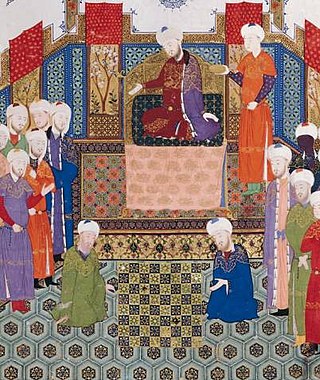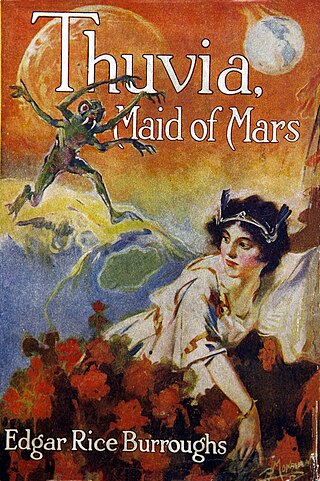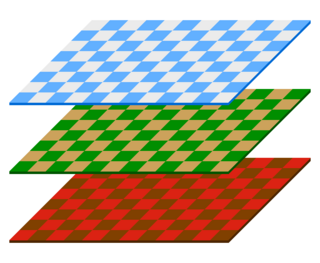
A chess piece, or chessman, is a game piece that is placed on a chessboard to play the game of chess. It can be either white or black, and it can be one of six types: king, queen, rook, bishop, knight, or pawn.

Shatranj is an old form of chess, as played in the Sasanian Empire. Its origins are in the Indian game of chaturaṅga. Modern chess gradually developed from this game, as it was introduced to Europe by contacts in Muslim Al-Andalus and in Sicily in the 10th century.

Chaturanga is an ancient Indian strategy board game. It is first known from India around the seventh century CE, but its roots may date 5000 years back, to the Indus Valley Civilization.
A fairy chess piece, variant chess piece, unorthodox chess piece, or heterodox chess piece is a chess piece not used in conventional chess but incorporated into certain chess variants and some chess problems. Compared to conventional pieces, fairy pieces vary mostly in the way they move, but they may also follow special rules for capturing, promotions, etc. Because of the distributed and uncoordinated nature of unorthodox chess development, the same piece can have different names, and different pieces can have the same name in various contexts as it can be noted in the list of fairy chess pieces.
Martian Chess is an abstract strategy game for two or four players invented by Andrew Looney in 1999. It is played with Icehouse pyramids on a chessboard. To play with a number of players other than two or four, a non-Euclidean surface can be tiled to produce a board of the required size, allowing up to six players.

Janggi, sometimes called Korean chess, is a strategy board game popular on the Korean Peninsula. The game was derived from xiangqi, and is very similar to it, including the starting position of some of the pieces, and the 9×10 gameboard, but without the xiangqi "river" dividing the board horizontally in the middle.

Sittuyin, also known as Burmese chess, is a strategy board game created in Myanmar. It is a direct offspring of the Indian game of chaturanga, which arrived in Myanmar in the 8th century thus it is part of the same family of games such as chess, and shogi. Sit is the modern Burmese word for "army" or "war"; the word sittuyin can be translated as "representation of the four characteristics of army"—chariot, elephant, cavalry and infantry.

A Princess of Mars is a science fantasy novel by American writer Edgar Rice Burroughs, the first of his Barsoom series. It was first serialized in the pulp magazine All-Story Magazine from February–July, 1912. Full of swordplay and daring feats, the novel is considered a classic example of 20th-century pulp fiction. It is also a seminal instance of the planetary romance, a subgenre of science fantasy that became highly popular in the decades following its publication. Its early chapters also contain elements of the Western. The story is set on Mars, imagined as a dying planet with a harsh desert environment. This vision of Mars was based on the work of the astronomer Percival Lowell, whose ideas were widely popularized in the late 19th and early 20th centuries.

Thuvia, Maid of Mars is a science fantasy novel by American writer Edgar Rice Burroughs, the fourth of the Barsoom series. The principal characters are Carthoris and Thuvia of Ptarth, each of whom appeared in the previous two novels.
Tamerlane chess is a medieval chess variant. Like modern chess, it is derived from shatranj. It was developed in Central Asia during the reign of Emperor Timur, and its invention is also attributed to him. Because Tamerlane chess is a larger variant of chaturanga, it is also called Shatranj Al-Kabir, as opposed to Shatranj as-saghir. Although the game is similar to modern chess, it is distinctive in that there are varieties of pawn, each of which promotes in its own way.

The Gods of Mars is a science fantasy novel by American writer Edgar Rice Burroughs and the second of Burroughs' Barsoom series. It features the characters of John Carter and Carter's wife Dejah Thoris. It was first published in The All-Story as a five-part serial in the issues for January–May 1913. It was later published as a complete novel by A. C. McClurg in September, 1918 and in many editions subsequently.

Dragonchess is a three-dimensional fantasy chess variant created by Gary Gygax, co-creator of the famed role-playing game Dungeons & Dragons. The game was introduced in 1985 in issue No. 100 of Dragon Magazine.

The Chessmen of Mars is a science fantasy novel by American writer Edgar Rice Burroughs, the fifth of his Barsoom series. Burroughs began writing it in January, 1921, and the finished story was first published in Argosy All-Story Weekly as a six-part serial in the issues for February 18 and 25 and March 4, 11, 18 and 25, 1922. It was later published as a complete novel by A. C. McClurg in November 1922.

Barsoom is a fictional representation of the planet Mars created by American pulp fiction author Edgar Rice Burroughs. The first Barsoom tale was serialized as Under the Moons of Mars in pulp magazine The All-Story from February to July 1912 and published compiled as a novel as A Princess of Mars in 1917. It features John Carter, a late-19th-century American Confederate veteran who is mysteriously transported from Earth to the dying world of Mars where he meets and romances the beautiful Martian princess Dejah Thoris. Ten sequels followed over the next three decades, further extending his vision of Barsoom and adding other characters.

Renegade of Callisto is a science fantasy novel by American writer Lin Carter, the eighth and last in his Callisto series. It was first published in paperback by Dell Books in August 1978, and reprinted once, in November of the same year. A tribute to Edgar Rice Burroughs's The Chessmen of Mars, the book introduces the game of Darza, Carter's equivalent of Jetan. An appendix details the rules.
Thark or Tharks are a fictional tribe of fierce Green Martian warriors on the fictional planet of Barsoom, created by Edgar Rice Burroughs and first featured in the 1917 novel A Princess of Mars.
This glossary of board games explains commonly used terms in board games, in alphabetical order. For a list of board games, see List of board games; for terms specific to chess, see Glossary of chess; for terms specific to chess problems, see Glossary of chess problems.
Grant Acedrex is a medieval chess variant dating back to the time of King Alfonso X of Castile. It appears in the Libro de los Juegos of 1283.

A chess variant is a game related to, derived from, or inspired by chess. Such variants can differ from chess in many different ways.













